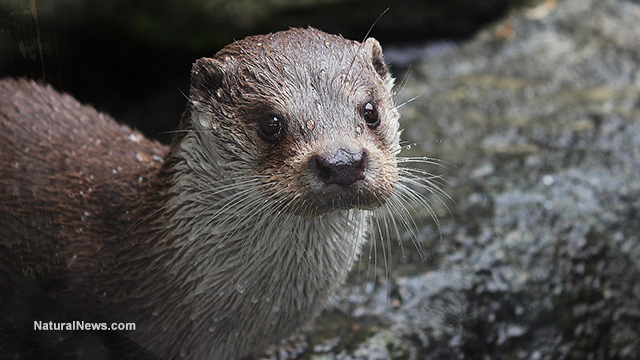Poisoned oceans are cutting otters' lifespans by two-thirds
Monday, February 15, 2016 by: PF Louis
Tags: ocean pollution, sea otters, heavy metals

(NaturalNews) Otters have had issues verging on threatened extinction in the early 20th Century. They were trapped and killed for their thick-layered furs that protect them from water and frigid conditions. Restrictions or bans on killing otters for fur has helped their numbers rise again.
In addition to the thick double-layered furs that protect these semi-aquatic amphibious mammals of the weasel family, they have webbed feet with claws at the ends of their four short legs and a wide tail that helps propel them through water. The sea otters tend to spend more time in water then their river otter cousins.
Their noses and ears shut automatically under water, where they can remain for eight minutes or so before coming up for air. Otters feed mostly on fish but also on various shellfish, mussels and turtles. National Geographic considers them to be "very sensitive to environmental pollution."
This sensitivity places otters among the coal mine canaries that were once used as warnings of subterranean air becoming too toxic.
A Scottish otter concern that went mainstream
A Scotland mainstream daily, The Scotsman, featured concerned comments from zoologist Dr. Paul Yoxon about Scotland's diminishing otter population. Dr. Yoxon and his biologist wife, Grace, manage the International Otter Survival Fund (IOSF), which has rescued 180 otters while researching why they are beginning to dwindle in numbers again.A major reason is that Scottish otters' lifespans have been reduced by two-thirds compared to their German counterparts. This gives the female otters less time to reproduce baby otters, usually two at a time, of which only half survive into adulthood.
The European mainland has cleaned up its act enough after an EU report a couple of years ago warned of EU coastal waters becoming overburdened by industrial toxic waste. Apparently, the UK and Scotland did little with those warnings. Scotland has 7,000 of the UK's 10,000 otter population.
Toxicology reports indicate high amounts of mercury and cadmium in otters that dine on mostly fish which contain the mercury and cadmium from industrial pollution that has spewed into the North Sea off Scotland's coast. Dr. Yoxon comments on additional new toxins that are polluting the water:
"Another group of chemicals have now appeared in the environment -- polybrominated diphenyl ethers (PBDEs), which are used as flame retardants in carpets, car seats and furnishings. These also accumulate in the environment and become concentrated in fish taken by otters, and can cause problems with the immune system."
In addition to industrial chemicals and pharmaceutical drugs, BPA from plastics and personal care products create xenoestrogenic imbalances that affect breeding with genital mutations.
Dr. Yoxon noted the actual reproductive effects on the otters: "They appear to be reducing the size of the male otter's penis -- by about five per cent over the last decade -- which obviously affects reproduction as well.
"The disappearance of the otter in the UK in the 1950s and 1960s went largely unnoticed until, suddenly, everyone began to ask where all our otters had gone. ... We cannot afford to make the same mistake again."
Not just a local Scottish problem
Everywhere there are oceans, various forms of sea life are showing signs of a tipping point pollution imbalance. Our earth's oxygen-generating ecosystem is being hampered by disappearing plankton, which also feed some surface sea creatures.Starfish and sea lions are dying on the American Pacific coast. Tuna are showing up with Fukushima radiation particles. Mutated sharks from the Gulf of Mexico and two-headed dolphins floating onto Turkish shores are more omens of oceanic chemical imbalances.
The mad rush into DuPont's old slogan of "Better Living Through Chemistry" without regard for toxic ecological implications has brought oceanic Earth to this tipping point.
Sources for this article include:
http://www.scotsman.com
http://www.naturalnews.com
http://www.naturalnews.com
http://animals.nationalgeographic.com
http://animals.nationalgeographic.com
http://science.naturalnews.com
Ocean pollution at FETCH.news
Get independent news alerts on natural cures, food lab tests, cannabis medicine, science, robotics, drones, privacy and more.
Take Action: Support Natural News by linking to this article from your website
Permalink to this article:
Embed article link: (copy HTML code below):
Reprinting this article:
Non-commercial use OK, cite NaturalNews.com with clickable link.
Follow Natural News on Facebook, Twitter, Google Plus, and Pinterest
- Newly released JFK files reveal Pentagon's role in creating Lyme disease and covid in the same lab
- Oncologist warns of ‘terrifyingly aggressive’ cancers in children, linked to immune suppression from COVID vaccines
- Trump administration CUTS FUNDING to Gavi, the Vaccine Alliance - a major blow to the Bill Gates-backed entity
- NIH study, buried for decades, reveals that Flu Shots INCREASE elderly deaths, not prevent them
- Health Ranger Report: Ashton Forbes discusses TELEPORTATION ORBS and their role in MH370 disappearance
- Musk targets “strangely wealthy” lawmakers in DOGE probe, names Pelosi, McConnell, Schumer
- COVID-19 scandal linked to CANCER SURGE: Billionaire researcher sounds alarm
- Millionaire fitness coach charged in Tesla vandalism incident as anti-Musk attacks escalate
- “Ethically sourced” human “bodyoids” could usher in a new era of medical exploitation, raising disturbing ethical questions
- EPA banned chemical linked to cancer, Parkinson's and fatal heart defects in babies - now industry is lobbying to get it reinstated
- Woman contracts WORLD'S DEADLIEST VIRUS after unknowingly being given the WRONG VACCINE
- DARPA: The shadowy innovator behind the world’s most advanced military technologies
- Ancient kitchen secrets REVEALED: How garlic, ginger and green onions fight cancer and heart disease
- Civil war is here – Multiple events, from conservatives being “swatted,” to attacks against Telsa owners, happening across America as Dem politicians are telling supporters to ‘fight in the streets”
- Tackling the rubber waste crisis: Groundbreaking study reveals eco-friendly method to recycle tires
- RFK Jr. is pushing Big Pharma ad ban - and corporate media is panicking
- NYT admits U.S. ran Ukraine war operations-Russia's victory exposes obsolete NATO tactics, says Mike Adams
- Homesteading Boom: How families are escaping cities to grow their own food
- Newly released JFK files reveal Pentagon's role in creating Lyme disease and covid in the same lab
- Analysis: The coming economic collapse, a mass uprising and Trump's three secret weapons to halt the growing revolt
- Trump's greatest betrayal so far: Accelerating Middle East wars, silencing dissent, and serving Zionist masters
- CDC finally halts $11 billion COVID funding scam as health officials admit the ‘pandemic’ was a fraud
- The hidden dangers in your kitchen: How cooking methods impact diabetes, cancer and aging
- Kiss Your Genetic Privacy Good-Bye! 23andMe Gets Green Light to Sell Your Intimate Genetic Details to Anyone They Want
- DEADLY DECEPTION: How COVID vaccines increased mortality rates and why authorities hid the truth
- Dr. Suzanne Humphries makes bombshell appearance on Joe Rogan podcast, exposing vaccine industry deception back to POLIOMYELITIS
- Trump nominates VACCINE ZEALOT Susan Monarez to lead the CDC, sidelining RFK Jr.'s reform efforts
- Here are TEN all-natural ways to protect your garden without using harmful chemicals
- Woman contracts WORLD'S DEADLIEST VIRUS after unknowingly being given the WRONG VACCINE
- Senate Democrats deny censorship industrial complex existed, defend government's role in silencing dissent
- Black cumin seed oil emerges as a powerful ally against breast cancer and chronic inflammation
- Sugar-free deception: Artificial sweeteners hijack hunger signals, fuel obesity epidemic, study warns
- “Independent” anti-Russia outlet MEDUZA faces COLLAPSE as US funding dries up
- The Health Ranger releases “Vaccine Zombie” song and music video, using AI-animated zombies for the music video
- Discovery of vast underground city beneath Giza pyramids challenges human history
- Key nodes of Federal Government censorship
- Newly released JFK files reveal Pentagon's role in creating Lyme disease and covid in the same lab
- California's social media censorship law struck down: A victory for free speech or a threat to online safety?
- EPA advisor admits the agency is funneling billions to climate groups ahead of Trump’s return to White House
- The Health Ranger releases “Vaccine Zombie” song and music video, using AI-animated zombies for the music video
- Dr. Mike Yeadon releases 15-minute testimony - WATCH - about genocidal intent of COVID “vaccines”
- Florida takes a stand: DeSantis proposes permanent ban on mRNA vaccine mandates
- “Why we influenced the 2020 elections”: Facebook files reveal the coordinated effort to bury the Hunter Biden laptop story
- Mike Adams releases country western hit single: Goin’ Back in Time is Comin’ Home
- The pandemic as a tool for INDOCTRINATION: Understanding “The Indoctrinated Brain” by Dr. Michael Nehls
- Unpacking the Lies That We’ve Been Fed – new song and music video released by Mike Adams, the Health Ranger
- Mike Adams releases music poetry sensation: A Child of God
- House Intelligence Committee calls for the ARREST and PROSECUTION of Dr. Anthony Fauci
- Rep. Nancy Mace introduces bill to ban biological males from female facilities on federal property
- Michigan sheriff announces criminal investigation into 2020 election crimes, Dominion Voting Systems
- Peter Rost exposes Big Pharma corruption in his book “The Whistleblower: Confessions of a Healthcare Hitman”
- Migrants are taking advantage of recent hurricanes to scam residents and loot their homes
- Sugarcane extract superior to cholesterol-lowering drugs?
- Survival 101: Effective EMF blocking techniques
- Red Cross issues warning to stop blood plasma donations from vaccinated people
- Scientists confirm: GENIUS brain function can be spontaneously unleashed in humans without any apparent cause
- EPA advisor admits the agency is funneling billions to climate groups ahead of Trump’s return to White House
- HYSSOP: What research reveals about the health benefits of this ancient holy herb
- Two containers with completed ballots fall out of truck in Florida
- Fully vaccinated about to see “tsunami” of illness and death, warns virologist
- Global leaders unite to clamp down on “misinformation” with UN-backed Cascais Declaration
- BREAKING: 2025 NDAA authorizes mandatory military draft of WOMEN across America… as Pentagon pursues global NUCLEAR war with both Russia and China at the same time
- Michael Yon warns of a ZIONIST TAKEOVER in Trump’s second administration
- BOMBSHELL: DNA testing kits are a SCAM to develop ethnic-specific bioweapons
- Ozempic and Wegovy weight loss drugs are injectable LIZARD VENOM PEPTIDES that may unleash a devastating wave of organ failure… side effects align with symptoms of SNAKE BITES
- Israeli soldiers accused of even more torture and abuse in the West Bank
- These 13 countries just signed an agreement to engineer a global FAMINE by destroying food supply
- NASA admits that climate change occurs because of changes in Earth’s solar orbit, and NOT because of SUVs and fossil fuels
- RFK Jr. clears key hurdle: Sen. Susan Collins backs controversial HHS nominee, signaling a new era for health policy
- Sermon 30: How Jesus reveals Caesar’s FAKE CURRENCY and FALSE AUTHORITY
- Coriander seeds: Ancient medicine backed by modern science
- Arizona officials claim Maricopa County needs 10-13 days to tabulate results of the election
Science News & Studies
Medicine News and Information
Food News & Studies
Health News & Studies
Herbs News & Information
Pollution News & Studies
Cancer News & Studies
Climate News & Studies
Survival News & Information
Gear News & Information
News covering technology, stocks, hackers, and more



"Big Tech and mainstream media are constantly trying to silence the independent voices that dare to bring you the truth about toxic food ingredients, dangerous medications and the failed, fraudulent science of the profit-driven medical establishment.
Email is one of the best ways to make sure you stay informed, without the censorship of the tech giants (Google, Apple, Facebook, Twitter, YouTube, etc.). Stay informed and you'll even likely learn information that may help save your own life."
–The Health Ranger, Mike Adams












































